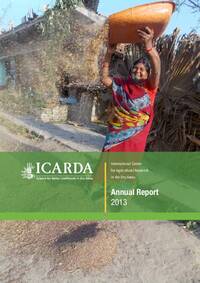ICARDA Annual Report 2013

Authors:
2013 has been a fruitful year for ICARDA marked by research accomplishments and a sense of gratitude. Our longstanding partner countries provided important support in making decentralization of the Center’s research a reality. This transition positions our research programs to more expressly target agroecosystem-based solutions, needed for wider impacts.
The effects of climate change are already being felt in the fragile agroecosystems of the drylands, as challenges are increasing for millions of smallholder farmers dependent on them. Scalable solutions are urgently needed to enable a sustainable food-secure future. The decentralization of ICARDA’s research and capacity development from Tel Hadya, Syria, during 2013 perhaps comes timely. New research sites have been strategically established in Morocco, Ethiopia, Sudan, Egypt, Turkey/Central Asia and India to allow the Center’s scientists to contribute more adequately to 10 CGIAR Research Programs, particularly the Dryland Systems program that ICARDA leads. The new setup is also powering up our approach of developing integrated solutions targeted to specific agroecosystems and their livelihood needs, through partnerships with the National Agricultural Research Systems (NARS) and other research institutions.
Our ties with NARS were further strengthened this year as host countries opened their doors, shared their research facilities and most of all, joined hands with the Center in our newly aligned research programs for the larger good.
We are also pleased to share the scaling out of some important research outcomes and their impacts in 2013. For example, the innovative adaptation of raised bed machines to small-scale farming – developed with farmers and private sector in Sharkia province in Egypt – delivers a 24% saving in irrigation water and is now being scaled out to other provinces and countries, such as Sudan, Ethiopia, Eritrea, Nigeria, Iraq, and Morocco.
In another significant progress in Africa, funded by the African Development Bank, heat-tolerant wheat varieties, developed in partnership with Sudan over many years, are beginning to enhance incomes and food security in Ethiopia’s lowlands and in Nigeria, where yields are more than doubling. The results are encouraging Nigerian policy-makers to rethink their national strategy and reduce reliance on imports.
For conservation agriculture, converting conventional seeders to ‘zero till’ machines with local private manufacturers is proving catalytic for the uptake of the sustainable practice in multiple countries – including Iraq, Jordan, Morocco. The innovation slashed the cost of seeders, making them far more affordable for smallholders in low-income countries.
The HSAD-Iraq program, funded by USAID, delivered on its promise of strengthening the country’s agriculture sector in a short time through a range of strategic interventions like strengthening the key commodity value chain of date palms, improving certified wheat seed production, and guiding the reform of seed regulations for a robust seed system.
Also, the Dryland Systems program came into full swing in 2013, ready for collective learning, testing and delivery of systems solutions. The program launched 15 Innovation Platforms across the drylands, stretching from the West Africa Sahel to Central and South Asia. Multidisciplinary teams of researchers, policy makers, academia, NGOs and the private sector were mobilized for each platform and are now moving forward to find integrated solutions for drylands in this one-of-a-kind global challenge.
In sum, we are more energized and better positioned than ever before to bring larger impacts for smallholder communities in drylands.
